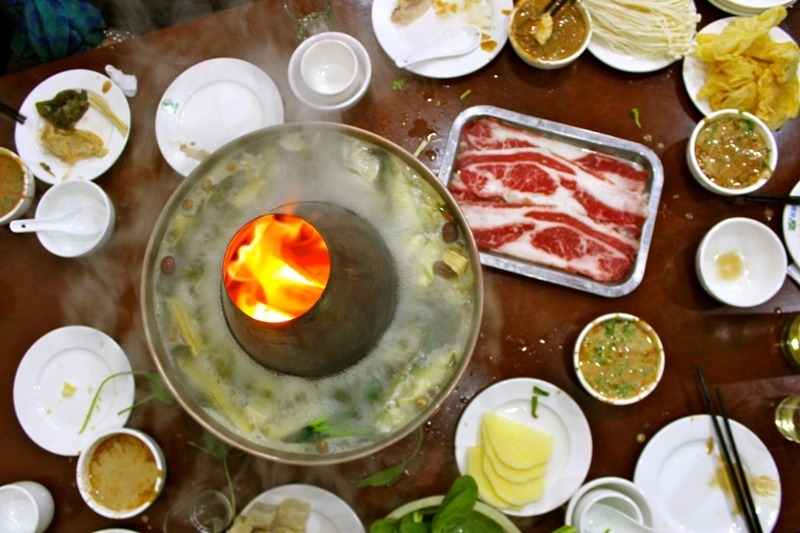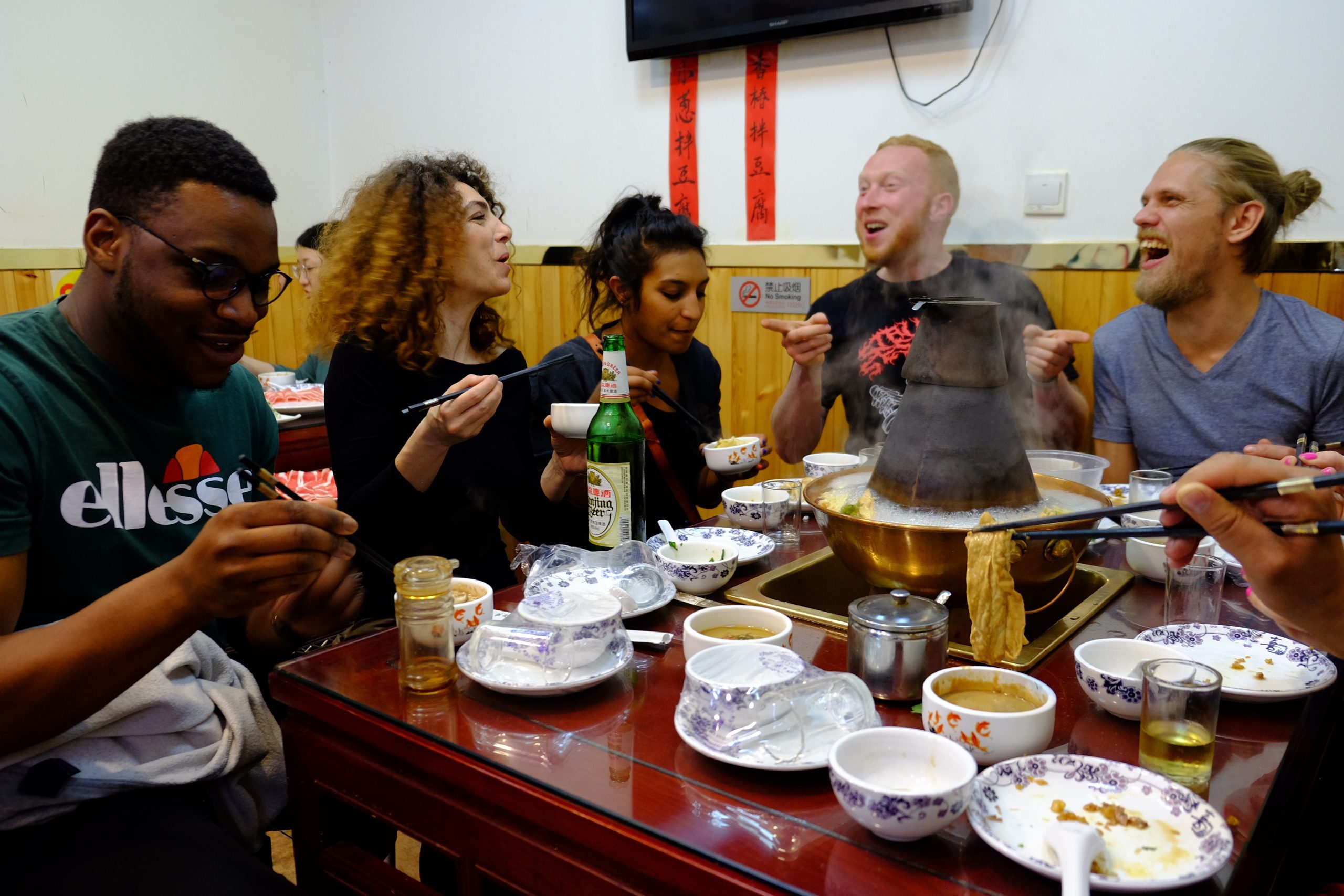We’re often asked by guests on the Old Beijing Dinner Tour about what makes Beijing hotpot dipping sauce so delicious. Developed over centuries since the Yuan Dynasty (1271-1368), the sauce makes use of some of Beijing people’s best-loved and most-used condiments, including sesame paste, fermented tofu and fermented Chinese chives.
We’ve previously posted two Beijing hotpot dipping sauce recipes: a simple, speedy recipe using these core ingredients to make a tasty Beijing hotpot dipping sauce at home and a more restaurant-quality one. But this video and accompanying **detailed** recipe gives a full picture of the kinds of ingredients and techniques traditionally used to produce Beijing hotpot dipping sauce in its highest form.
With that in mind, we’ve posted the video above of state banquet head chef and Beijing native Zheng Xiusheng sharing his own method of making Beijing hotpot dipping sauce. The video does not have English subtitles, but we’ve listed the ingredients and provided Chef Zheng’s notes below.
This Beijing hotpot dipping sauce is made with peanut butter and sesame paste, a fragrant infused water, plus “Eight Small Bowls” of seasonings. It is then served with “Four Small Dishes” of condiments. Whether you try to replicate this recipe exactly, use it for ideas on what to add to your own recipe, or simply watch to gain an appreciation of the secrets behind the sauce, we hope you’ll enjoy seeing how local Beijing chefs prepare one of the city’s most iconic dishes.
A couple important things to note:
- This recipe is mostly about getting your mise en place together for the final stir together.
- Chef Zheng rarely uses measurements, and the best thing about hotpot sauce is you can make it to your liking. Constantly tasting as you add ingredients is the best way to see if you like it, so start small and add more as you go.
 Ingredients for Infused Water
Ingredients for Infused Water
- ~30 ml of water (it’s good to have extra)
- 2 bay leaves (香叶)
- 1 tsp fennel seeds (小茴香)
- 1/2 tsp Sichuan peppercorns (花椒)*
- 1 small piece of angelica root (白芷)
- 1 small piece of sand ginger / galangal (三奈)
- 1 nutmeg (肉蔻)
- 1 white cardamom (豆蔻)
- 1 star anise (八角/大料)**
*Sichuan peppercorns and mutton go well together
**An old saying goes that mutton and star anise don’t go well together but Chef Zheng likes the combination and adding only a little is fine.
Method for Infused Water
- Bring this to the boil then remove from heat, allow to cool and strain into a bowl.
Ingredients for Chili Oil
- Peanut oil
- Sesame Oil
- Dried Chilies
- Raw Sesame Seeds
Method for Chili Oil
To make the chilli oil, heat peanut oil and sesame oil in a wok until they just begin to smoke as Chef Zheng removes it from the heat, and slowly ladle over dried chillies, then stir in some raw sesame seeds.
Ingredients for “Four Small Dishes”
The four small dishes are:
- Spring onion (小葱) or Chinese leek (大葱 -technically called Welsh onion in English, which is what it looks like).
- Fresh coriander / cilantro (香菜)
- Pickled potherb mustard (雪菜, picked 雪里红)*
- Sweet garlic (糖蒜)**
*Substituting another Chinese pickled vegetable will yield a similar result. Thoroughly wash the pickled vegetable and leave it to dry before chopping.
**This is a sweet pickled garlic that can be substituted for other pickled garlic or omitted.
Method for “Four Small Dishes”
Finely chop all of these ingredients.
Ingredients for “Eight Small Bowls”
The eight small bowls are:
- Rice vinegar (米醋)
- Sesame oil (香油)
- Light soy sauce (酱油)
- Cooking wine/yellow rice wine/Shaoxing wine (黄酒)
- Shrimp oil (虾油)*
- Fermented tofu 酱豆腐,
- Fermented Chinese chives 韭菜花,
- Chili oil 辣椒油**
Also introduced here: Peanut butter 花生酱 and Sesame paste 芝麻酱.***
*If you don’t have shrimp oil, use shrimp sauce (虾酱). If you don’t have shrimp sauce, use fish sauce (鱼露). UnTour’s note: You can also use oyster sauce or vegetarian oyster sauce.
**This is one of the Eight Small Bowls but is served alongside the Four Small Dishes for diners to add to their sauce to their taste.
***Sesame paste and peanut butter don’t count among the Eight Small Bowls. It should be a “three-seven Sauce”, three parts sesame paste and seven parts peanut butter. UnTour’s note: This sauce is known as two-eight sauce in Beijing and is made from two parts peanut butter and eight parts sesame paste. The other chefs suggest Chef Zheng has the proportions backward, but he remains adamant.
Putting Your Beijing Hotpot Dipping Sauce Together
- Mix the peanut butter and sesame paste together.
- Add a splash of soy sauce and continue stirring.*
- Add vinegar and stir.**
- Add 15g fermented Chinese chive paste and stir.***
- Add fermented tofu and stir.
- Add 10g shrimp oil an stir.****
- Add cooking wine and stir.*****
- Add sesame oil and stir.
- Add peanut butter and stir.******
- Add around 30ml of the infused water.
The consistency should thickly coat the back of your spoon, but should definitely be a sauce, not a paste. Seeing Chef Zheng straining the sauce gives a good indication of the consistency.
*Chef Zheng is adding the soy sauce until the sauce looks the right color and noting not to add too much or the sauce will be to salty.
**A lot of Beijing hotpot restaurants don’t add vinegar to their dipping sauce because it makes it difficult to store, but vinegar definitely needs to be added before you eat it.
***Beijingers like fermented Chinese chive paste, so put a good amount in. UnTour’s note: Immediately after giving his first exact measurement, he then says there’s no limit to the amount you can add. Add to your taste.
****Don’t add too much shrimp oil or it will be too salty.
*****Add a good measure of the cooking wine but don’t add too much.
******”This peanut butter has too many chunks in it. It’s better to buy a smoother one”. Chef Zheng later only strains the sauce it to remove the peanut chunks.
How to Hotpot with Beijing Dipping Sauce
The chefs conclude the video by remarking that they haven’t prepared the hotpot to go with the sauce and making plans to do so – but don’t worry! We can show you how to hotpot. Here’s a few ways:
- If you’d like to see the process of how Beijing hotpot is prepared and eaten, you can check out our Instagram and watch the Old Beijing Dinner Tour on YouTube.
- If you’d like to see, participate in and taste authentic Beijing hotpot in the hutongs, you can book a tour here on the UnTour Food Tours Website.
- If you aren’t in China and still want to make it at home, you can also check out our blog: UnTour Beijing’s Mongolian-Style Hotpot Recipe.
Finally, if you do make your own Beijing hotpot dipping sauce, please send us some photos of your efforts at info@untourfoodtours.com. We’d love to see them and perhaps share a few!
Good luck and happy eating!



